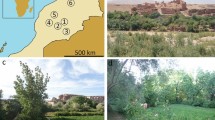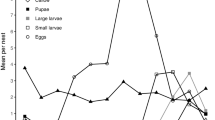Abstract
Aculeate Hymenoptera have two modes of overwintering. In solitary species, adults usually do not emerge before winter and overwinter in their natal nests. In the majority of social species, adults activate before winter and only inseminated females perform overwintering. We examined the winter survival strategy in four species of small carpenter bees (Ceratina) in which both sexes activate before winter and overwinter as adults. All of the species studied are able to use their old nests, nests of other Ceratina species, or newly excavated burrows for overwintering. However, the species differ in their strategy. Ceratina cucurbitina usually overwintered in social hibernacula with a large number of individuals, but social hibernation was less often present in C. nigrolabiata. On the other hand, individuals of C. chalybea and C. cyanea overwintered predominantly solitary. Interestingly, we detected female individuals that attempted to overwinter for a second time in all species. Surprisingly, males of C. nigrolabiata and C. chalybea are also able to overwinter for a second time in rare cases. These males lived for more than 1.5 years; therefore, they are the longest living bee-males known to date.




Similar content being viewed by others
References
Addo-Bediako A, Chown SL, Gaston KJ (2000) Thermal tolerance, climatic variability and latitude. Proc R Soc Lond B Biol Sci 267:739–745
Alcock J (2013) Sexual selection and the mating behavior of solitary bees. In: Brockmann HJ, Naguib TJRM, Mitani JC, Simmons LW, Barrett L (eds) Advances in the study of behavior. Academic Press, New York, pp 1–48
Alford DV (1969) A study of the hibernation of bumblebees (Hymenoptera: Bombidae) in southern England. J Anim Ecol 38:149–170
Bale JS, Hayward S et al (2010) Insect overwintering in a changing climate. J Exp Biol 213:980–994. https://doi.org/10.1242/jeb.037911
Bogusch P, Macek J, Janšta P et al (2016) Industrial and post-industrial habitats serve as critical refugia for pioneer species of newly identified arthropod assemblages associated with reed galls. Biodivers Conserv 25:827–863
Carey JR (2001) Demographic mechanisms for the evolution of long life in social insects. Exp Gerontol 36:713–722. https://doi.org/10.1016/S0531-5565(00)00237-0
Daly HV (1983) Taxonomy and ecology of Ceratinini of North Africa and the Iberian Peninsula (Hymenoptera: Apoidea). Syst Entomol 8:29–62. https://doi.org/10.1111/j.1365-3113.1983.tb00466.x
Dew RM, Shell WA, Rehan SM (2018) Changes in maternal investment with climate moderate social behaviour in a facultatively social bee. Behav Ecol Sociobiol 72:69. https://doi.org/10.1007/s00265-018-2488-4
Fründ J, Zieger SL, Tscharntke T (2013) Response diversity of wild bees to overwintering temperatures. Oecologia 173:1639–1648. https://doi.org/10.1007/s00442-013-2729-1
Gerling D, Hermann HR (1978) Biology and mating behavior of Xylocopa virginica L. (Hymenoptera, Anthophoridae). Behav Ecol Sociobiol 3:99–111
Gibo DL (1980) Overwintering of Polistes fuscatus in Canada: use of abandoned nests of Dolichovespula arenaria. J N Y Entomol Soc 88:146–150
Gill HK, Goyal G, Chahil G (2017) Insect diapause: a review. J Agric Sci Technol A 7:454–473
Greene A (1991) Dolichovespula and Vespula. The Social Biology of Wasps. Cornell University Press, Ithaca
Gros A, Hovestadt T, Poethke HJ (2008) Evolution of sex-biased dispersal: the role of sex-specific dispersal costs, demographic stochasticity, and inbreeding. Ecol Model 219:226–233
Heinze J (2016) The male has done his work: the male may go. Curr Opin Insect Sci 16:22–27. https://doi.org/10.1016/j.cois.2016.05.005
Keller L, Genoud M (1997) Extraordinary lifespans in ants: a test of evolutionary theories of ageing. Nature 389:958–960. https://doi.org/10.1038/40130
Kidokoro M, Azuma N, Higashi S (2006) Pre-hibernation mating by a solitary bee, Ceratina flavipes (Hymenoptera: Apidae: Xylocopinae). J Nat Hist 40:2101–2110. https://doi.org/10.1080/00222930601051345
Koeniger G (2005) The neglected gender: males in bees. Apidologie 36:143–144. https://doi.org/10.1051/apido:2005017
Kokko H, Jennions MD (2008) Parental investment, sexual selection and sex ratios. J Evol Biol 21:919–948. https://doi.org/10.1111/j.1420-9101.2008.01540.x
Lewis V, Richards MH (2017) Experimentally induced alloparental care in a solitary carpenter bee. Anim Behav 123:229–238. https://doi.org/10.1016/j.anbehav.2016.11.003
Lopez-Uribe MM, Zamudio KR, Cardoso CF, Danforth BN (2014) Climate, physiological tolerance and sex-biased dispersal shape genetic structure of Neotropical orchid bees. Mol Ecol 23:1874–1890. https://doi.org/10.1111/mec.12689
Maeta Y, Sugiura N, Goubara M (1992) Patterns of offspring production and sex allocation in the small carpenter bee, Ceratina flavipes Smith (Hymenoptera, Xylocopinae). Jpn J Ent 60:175–190
Martin SJ (1991) Notes on the over-wintering of the carpenter bee Xylocopa albinotum (Hymenoptera, Anthophoridae). Jpn J Ent 59:735–741
Michener CD (2007) The bees of the world, 2nd edn. The Johns Hopkins University Press, Baltimore
Michener CD (1990) Castes in xylocopine bees. In: Engels W (ed) Social insects. Springer, Berlin, pp 123–146
Mikát M, Černá K, Straka J (2016) Major benefits of guarding behavior in subsocial bees: implications for social evolution. Ecol Evol 6:6784–6797. https://doi.org/10.1002/ece3.2387
Mikát M, Franchino C, Rehan SM (2017) Sociodemographic variation in foraging behavior and the adaptive significance of worker production in the facultatively social small carpenter bee, Ceratina calcarata. Behav Ecol Sociobiol 71:135. https://doi.org/10.1007/s00265-017-2365-6
Mikát M, Janošík L, Černá K, Matoušková E, Hadrava J, Bureš V, Straka J (2019) Polyandrous bee provides extended offspring care biparentally as an alternative to monandry based eusociality. Proc Natl Acad Sci 116:6238–6243. https://doi.org/10.1073/pnas.1810092116
Mikát M, Waldhauserová J, Fraňková T, Čermáková K, Brož V, Zeman Š, Dokulilová M, Straka J (2020) Only mothers feed mature offspring in European Ceratina bees. Insect Sci. https://doi.org/10.1111/1744-7917.12859
Moore MV, Lee RE (1991) Surviving the big chill: overwintering strategies of aquatic and terrestrial insects. Am Entomol 37:111–118
Mordechai YB, Cohen R, Gerling D, Moscovitz E (1978) The biology of Xylocopa pubescens Spinola (Hymenoptera: Anthophoridae) in Israel. Isr J Entomol 12:107–121
Packer L (1983) The nesting biology and social organisation of Lasioglossum (Evylaeus) laticeps (Hymenoptera, Halictidae) in England. Insectes Soc 30:367–375. https://doi.org/10.1007/BF02223968
Packer L, Knerer G (1985) Social evolution and its correlates in bees of the subgenus Evylaeus (Hymenoptera; Halictidae). Behav Ecol Sociobiol 17:143–149
Plateaux-Quénu C (1992) Comparative biological data in two closely related eusocial species: Evylaeus calceatus (Scop.) and Evylaeus albipes (F.)(Hym., Halictinae). Insectes Soc 39:351–364
Prugnolle F, de Meeus T (2002) Inferring sex-biased dispersal from population genetic tools: a review. Heredity 88:161–165. https://doi.org/10.1038/sj.hdy.6800060
R Core Team (2014) R: a language and environment for statistical computing. R Foundation for Statistical Computing, Vienna, Austria. ISBN 3-900051-07-0
Rehan RMH, Schwarz MP (2010) Social polymorphism in the Australian small carpenter bee, Ceratina (Neoceratina) australensis. Insectes Soc 57:403–412. https://doi.org/10.1007/s00040-010-0097-y
Rehan SM, Richards MH (2010) Nesting biology and subsociality in Ceratina calcarata (Hymenoptera: Apidae). Can Entomol 142:65–74. https://doi.org/10.4039/n09-056
Rehan SM, Richards MH (2013) Reproductive aggression and nestmate recognition in a subsocial bee. Anim Behav 85:733–741. https://doi.org/10.1016/j.anbehav.2013.01.010
Röseler P-F, van Honk CGJ (1990) Castes and reproduction in bumblebees. In: Engels W (ed) Social insects. Springer, Berlin, Heidelberg, pp 147–166
Sakagami S, Maeta Y (1987) Multifemale nests and rudimentary castes of an “almost” solitary bee Ceratina flavipes, with additional abservations on multifemale nests of Ceratina japonica (Hymenoptera, Apoidea). Jpn J Entomol 55:391–409
Sakagami SF, Hoshikawa K, Fukuda H (1984) Overwintering ecology of two social halictine bees, Lasioglossum duplex and L. problematicum. Res Popul Ecol 26:363–378
Sakagami SF, Laroca S (1971) Observations on the bionomics of some neotropical xylocopine bees, with comparative and biofaunistic notes (Hymenoptera, Anthophoridae). J Fac Sci Hokkaido Univ Ser VI Zool 18:57–127
Sakagami SF, Maeta Y (1977) Some presumably presocial habits of Japanese Ceratina bees, with notes on various social types in Hymenoptera. Insectes Soc 24:319–343. https://doi.org/10.1007/BF02223784
Sakagami SF, Maeta Y (1989) Compatibility and incompatibility of solitary life with eusociality in two normally solitary bees Ceratina japonica and Ceratina okinawana (Hymenoptera, Apoidea), with notes on the incipient phase of eusociality. Jpn J Entomol 57:417–439
Sakagami SF, Maeta Y (1984) Multifemale nests and rudimentary castes in the normally solitary bee Ceratina japonica (Hymenoptera: Xylocopinae). J Kans Entomol Soc 57:639–656. https://doi.org/10.2307/25084573
Sakagami SF, Tanno K, Enomoto O (1982) Cold resistance of the small carpenter bee Ceratina flavipes restudied. Low Temp Sci Ser B Biol Sci 39:1–7
Schmid-Hempel P, Wolf T (1988) Foraging effort and life span of workers in a social insect. J Anim Ecol 57:509–521. https://doi.org/10.2307/4921
Shiokawa M (1966) Comparative studies of two closely allied sympatric Ceratina bees, C. flavipes and C. japonica II. Nest structure. Jpn J Entomol 34:44–51
Sinclair BJ (2015) Linking energetics and overwintering in temperate insects. J Therm Biol 54:5–11. https://doi.org/10.1016/j.jtherbio.2014.07.007
Skandalis DA, Richards MH, Sformo TS, Tattersall GJ (2011) Climate limitations on the distribution and phenology of a large carpenter bee, Xylocopa virginica (Hymenoptera: Apidae). Can J Zool 89:785–795
Straka J, Bogusch P, Přidal A (2007) Apoidea: Apiformes (včely). Annoted Checklist Aculeata Hymenoptera Czech Repubublic and Slovakia. Komentovaný seznam žahadlovỳch blanokřídlých (Hymenoptera: Aculeata) České Republiky a Slovenska. Acta Entomol Musei Natl Pragae Suppl 11:1–300
Straka J, Černá K, Macháčková L et al (2014) Life span in the wild: the role of activity and climate in natural populations of bees. Funct Ecol 28:1235–1244. https://doi.org/10.1111/1365-2435.12261
Stubblefield JW, Seger J (1994) Sexual dimorphism in the Hymenoptera. In: Shrot RV, Balaban E (eds) The differences between the sexes. Cambridge University Press, Cambridge, pp 71–103
Sugiura N (1995) Burrow construction by the Japanese carpenter bee, Xylocopa appendiculata circumvolans Smith, for overwintering (Hymenoptera: Anthophoridae). J Kans Entomol Soc 68:116–119
Tauber CA, Tauber MJ (1981) Insect seasonal cycles: genetics and evolution. Annu Rev Ecol Syst 12:281–308
Terzo M, Rasmont P (2011) Atlas of the European Bees: genus Ceratina. In: Atlas Hymenopt. Atlas Eur. Bees—STEP Proj. http://www.atlashymenoptera.net/page.asp?id=192. Accessed 26 Feb 2019
Vickruck JL, Richards MH (2017) Nestmate discrimination based on familiarity but not relatedness in eastern carpenter bees. Behav Processes 145:73–80
Wilson EO (1971) The insect societies. Belknap Press of Harvard University Press, Cambridge
Yamauchi K, Ishida Y, Hashim R, Heinze J (2006) Queen-queen competition by precocious male production in multiqueen ant colonies. Curr Biol 16:2424–2427. https://doi.org/10.1016/j.cub.2006.10.007
Yanega D (1990) Philopatry and nest founding in a primitively social bee, Halictus rubicundus. Behav Ecol Sociobiol 27:37–42. https://doi.org/10.2307/4600441
Acknowledgements
We would like to thank Karel Kodejš and Blanka Mikátová for their help with the field experiments. We are grateful to the office of Podyjí National Park for their permission to conduct the research and for their helpfulness. The Grant Agency of Charles University (GAUK 358315/2015) and the SVV project (Integrative Animal Biology) No. 260434/2018 supported this research.
Author information
Authors and Affiliations
Corresponding author
Additional information
Publisher's Note
Springer Nature remains neutral with regard to jurisdictional claims in published maps and institutional affiliations.
Supplementary information
Below is the link to the electronic supplementary material.
About this article
Cite this article
Mikát, M., Straka, J. Overwintering strategy and longevity of European small carpenter bees (Ceratina). J Ethol 39, 155–164 (2021). https://doi.org/10.1007/s10164-020-00688-6
Received:
Accepted:
Published:
Issue Date:
DOI: https://doi.org/10.1007/s10164-020-00688-6




